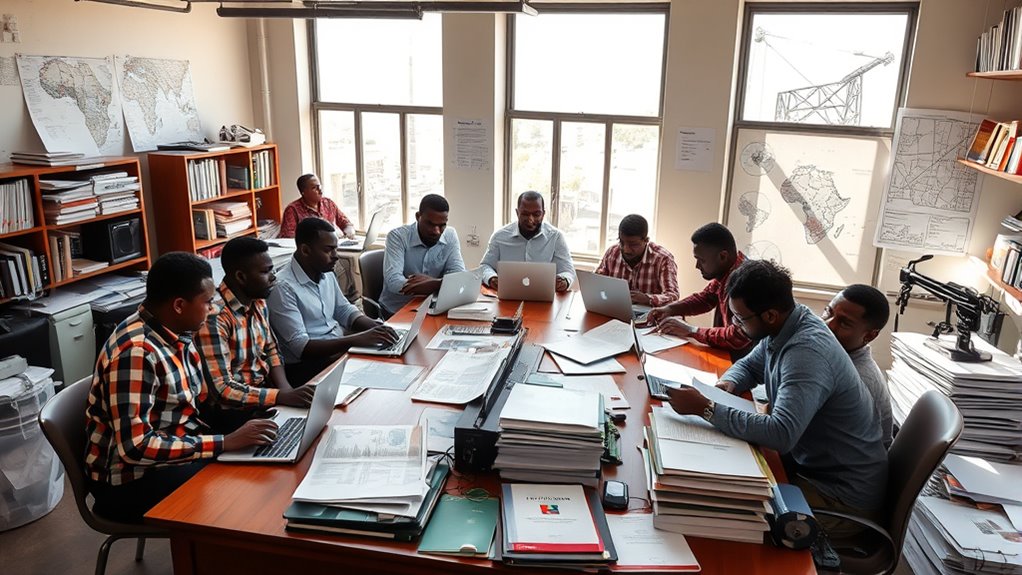Translation Africa specializes in professional translation services for technical manuals in Ethiopia, delivering accurate, culturally adapted content for industries like manufacturing, engineering, and healthcare. Their process guarantees precise terminology, rigorous editing, and localization to local dialects, enhancing safety, accessibility, and compliance with international standards. By addressing linguistic challenges, they support efficient operations and minimize risks. Insights into benefits, processes, and costs continue in the following overview.
Quick Summaries
- Professional translation services in Ethiopia specialize in adapting technical manuals for local languages like Amharic and Oromo.
- These services enhance safety and accessibility by providing accurate, culturally adapted instructions for machinery and healthcare equipment.
- Expert linguists with fluency in Ethiopian dialects ensure high-fidelity translations and adherence to international standards.
- The process includes thorough preparation, translation, editing, and localization to meet industry-specific requirements.
- Costs are determined by word count and project complexity, with options for rush fees to accommodate urgent timelines.
Benefits of Technical Manual Translation in Ethiopia

Technical manual translation in Ethiopia enhances accessibility to complex machinery and equipment, enabling local users to operate them safely and effectively. This process minimizes operational risks by providing clear, language-appropriate instructions, thereby reducing accidents and downtime in industries. Translated manuals foster skill development among workers, empowering them to maintain and troubleshoot equipment independently. Economically, it supports local businesses by improving efficiency and productivity, which contributes to job creation and technological advancement. Moreover, accurate translations guarantee compliance with international safety standards, promoting sustainable industrial growth. By bridging language barriers, these services facilitate knowledge transfer, allowing Ethiopia to integrate advanced technologies into its economy without reliance on foreign expertise. Overall, the benefits extend to safer workplaces, enhanced innovation, and broader economic empowerment.
Overview of Translation Africa Services

Translation Africa Services plays a key role in providing translation solutions for technical manuals in Ethiopia. Its service offerings encompass a variety of language support options, while highlighting expertise in translation processes. Technical specialties further enhance its capabilities in handling specialized content effectively.
Service Offerings
The service offerings of Translation Africa encompass expert translations for technical manuals, tailored to meet the demands of Ethiopia’s diverse sectors while ensuring accuracy and cultural relevance. These include extensive language services such as multilingual translations, localization for regional dialects, and document adaptation to industry standards. For instance, services cover sectors like agriculture, manufacturing, and healthcare, delivering precise terminology and context-specific adjustments. Translation Africa also provides editing, proofreading, and formatting to enhance readability and compliance. With flexible project management, clients receive customized packages that prioritize timely delivery and cost-effectiveness, fostering seamless integration of translated materials. This approach supports Ethiopia’s growing need for reliable technical communication, bridging language barriers without compromising quality. Overall, the offerings emphasize practical, client-focused solutions to drive operational success.
Translation Expertise
At the core of Translation Africa‘s operations lies a team of seasoned linguists and subject matter experts, delivering specialized knowledge in technical translations that adapt seamlessly to Ethiopia’s linguistic diversity. This expertise guarantees high-fidelity translations, blending linguistic precision with cultural nuances to maintain original intent. Translation Africa employs rigorous quality control processes, fostering reliable outcomes for complex manuals.
- Linguistic Proficiency: Experts fluent in Amharic, Oromo, and other Ethiopian languages, guaranteeing accurate terminology.
- Adaptation Strategies: Tailored approaches that address regional dialects and contextual relevance without altering technical essence.
- Collaborative Frameworks: Integration of client feedback loops for iterative improvements, enhancing overall service efficacy.
Technical Specialties
Building on the expertise in technical translations, Translation Africa offers specialized services across engineering, information technology, and healthcare sectors, ensuring manuals are accurately adapted for Ethiopia’s diverse industries. In engineering, the company handles machinery, construction, and infrastructure documents with precision, employing translators versed in technical jargon to avoid errors. For information technology, services cover software manuals, network guides, and digital tools, focusing on clarity and up-to-date terminology to support seamless implementation. In healthcare, translations encompass medical devices, pharmaceuticals, and protocols, adhering to regulatory standards for safety and efficacy. Translation Africa’s approach integrates cultural nuances and local languages, enhancing accessibility and reducing misinterpretation risks. This targeted expertise guarantees high-quality results tailored to Ethiopia’s specific needs, from urban development to rural health initiatives.
Industries Relying on Technical Translations

Various industries in Ethiopia depend on technical translations for their operations, including the manufacturing sector’s demands for precise documentation. The engineering industry requires accurate translations to address its specific needs in project implementation. Healthcare translation uses extend to ensuring safety and compliance in medical equipment manuals.
Manufacturing Sector Demands
The manufacturing sector in Ethiopia relies heavily on technical translations to support its expanding industries. As the country advances in production capabilities, accurate translations of manuals and documents are essential for operational efficiency, worker training, and compliance with global standards. This demand is driven by the need to adapt international technologies to local contexts, guaranteeing seamless integration and reduced errors in daily operations.
- Textile and Apparel Production: Translations facilitate precise handling of machinery, maintaining quality in fabric manufacturing and assembly processes.
- Food and Beverage Processing: Accurate renditions of equipment guides guarantee safe operations, hygiene protocols, and efficient processing to meet export standards.
- Consumer Goods Manufacturing: Technical documents for assembly lines help streamline production, minimize waste, and support workforce upskilling in a competitive market.
Engineering Industry Needs
Ethiopia’s engineering sectors increasingly depend on accurate technical translations to advance infrastructure and innovation. As the country expands projects in civil engineering, such as dams and roads, precise translations of blueprints and specifications guarantee seamless collaboration with international firms. In mechanical engineering, manuals for imported machinery must be flawlessly rendered to guarantee safe operations and maintenance protocols. Electrical engineering relies on accurate renditions of schematics and standards to integrate modern technologies effectively. Telecommunications engineering benefits from translated documents for network systems, enabling efficient deployment and upgrades. This demand highlights the role of specialized translation services in handling complex terminology, minimizing errors, and supporting Ethiopia’s drive for technological advancement and global partnerships in these fields. Overall, such translations are essential for fostering efficiency and reliability across the engineering landscape.
Healthcare Translation Uses
In healthcare, accurate technical translations enable Ethiopia’s medical sector to integrate international standards and equipment effectively, guaranteeing seamless adoption of advanced technologies and compliance with global protocols. This facilitates safer patient care, precise medical procedures, and enhanced collaboration with international partners, bridging language gaps in a rapidly evolving field.
- Medical Device Instructions: Accurate translations of manuals for imported equipment prevent operational errors and guarantee proper maintenance, safeguarding user safety.
- Pharmaceutical Documentation: Rendering drug labels and inserts precisely avoids dosage mistakes and supports effective treatment regimens in diverse linguistic contexts.
- Training and Research Materials: Translating educational resources and clinical studies allows healthcare professionals to access global knowledge, improving skills and innovation in Ethiopia’s facilities.
Steps in the Technical Manual Translation Process
Translating technical manuals demands a precise, multi-step process to guarantee accuracy and cultural relevance. First, the process begins with thorough preparation, where translators analyze the source material, including terminology, diagrams, and context, to understand its technical nuances. Next, professional linguists perform the initial translation, converting text while preserving original meaning and adhering to industry standards. This is followed by editing, where a second expert reviews the draft for linguistic accuracy, consistency, and flow. Localization then adapts the content to Ethiopian cultural and regional specifics, such as local dialects or measurement systems. Finally, formatting guarantees the translated manual maintains the original layout, integrating visuals and guaranteeing readability. Throughout, collaboration between subject matter experts and translators streamlines the workflow, making the manual user-friendly and effective.
Ensuring Quality and Accuracy in Translations
Guaranteeing quality and accuracy in technical manual translations involves implementing robust protocols from the outset. This process emphasizes meticulous planning, where translators adhere to standardized procedures to minimize errors and maintain fidelity to the source material. By prioritizing precision, organizations can deliver reliable documents that support effective user comprehension and safety.
- Rigorous Editing and Proofreading: Multiple review stages guarantee terminology consistency and eliminate inaccuracies before finalization.
- Use of Specialized Tools: Leveraging translation management software for glossaries and quality assurance checks enhances overall reliability.
- Adherence to Standards: Following international guidelines, such as ISO norms, guarantees that translations meet industry benchmarks for technical accuracy.
Expert Translators for Ethiopian Languages
Expert translators skilled in Ethiopian languages, such as Amharic and Oromo, are essential for accurately conveying technical manuals to diverse audiences in Ethiopia. These professionals possess specialized knowledge of linguistic nuances and technical terminology, ensuring that complex instructions remain precise and contextually appropriate. For instance, they adeptly handle the structural differences in languages like Tigrinya or Somali, maintaining the integrity of diagrams, safety protocols, and operational guidelines. Their expertise extends to industry-specific vocabularies, such as engineering or healthcare, enabling seamless adaptation for local users. By collaborating with subject matter experts, these translators deliver high-fidelity renditions that support effective communication and compliance. Ultimately, their role enhances accessibility, fostering better understanding and application of technical content across Ethiopia’s multilingual landscape.
Challenges and Solutions in Manual Translation
Manual translation of technical manuals in Ethiopia often involves obstacles like linguistic variations and cultural contexts that can distort meaning. These challenges arise from Ethiopia’s diverse languages and dialects, potentially leading to misinterpretations of complex terminology. Effective solutions require skilled translators who adapt content while preserving accuracy and intent.
- Linguistic Adaptation: Translators must navigate Ethiopia’s multilingual landscape by using specialized glossaries to guarantee precise term equivalence across languages like Amharic and Oromo.
- Cultural Sensitivity: Incorporating local customs into translations prevents misunderstandings, such as adapting safety instructions to align with Ethiopian work practices.
- Quality Assurance: Implementing peer reviews and iterative edits helps identify errors early, maintaining the manual’s technical integrity and usability.
Cost Factors for Translation Services
Several factors influence the costs of translation services for technical manuals in Ethiopia. Word count costs typically form the basis of pricing, with rates varying by the volume of text. Language pair pricing and rush service fees further adjust these costs based on the specific languages involved and the urgency of the project.
Word Count Costs
The cost of translation services for technical manuals in Ethiopia is largely influenced by word count, which serves as a key metric for pricing. Providers typically use per-word rates to calculate fees, ensuring transparency and scalability for projects of varying sizes. This approach helps businesses budget effectively while maintaining quality in specialized technical content.
- Per-word pricing structures: Rates are often tiered based on word volume, with standard fees for routine terms and higher charges for complex terminology in manuals.
- Impact on project timelines: Higher word counts can extend delivery times, indirectly affecting costs through potential rush fees or revisions.
- Efficiency considerations: Accurate word counts via tools like CAT software optimize pricing, reducing errors and enabling cost savings for repetitive phrases in technical documents.
Language Pair Pricing
Language pair pricing emerges as a significant factor in determining translation costs for technical manuals in Ethiopia, varying based on the specific languages involved. Common pairs, such as English to Amharic, typically result in lower rates due to the availability of skilled translators and high demand, making the process more efficient. In contrast, rarer combinations like English to Oromo or Tigrinya often incur higher fees because of limited expert resources and the need for specialized training to handle technical terminology accurately.
Factors such as language rarity, translator proficiency, and the bidirectional complexity—e.g., translating from a local language to English versus the reverse—further influence pricing. For technical manuals, ensuring precision in these pairs is vital, as errors could compromise safety protocols. Ultimately, providers like Translation Africa assess these elements to offer competitive, tailored quotes, helping clients balance quality and budget in Ethiopia’s diverse linguistic landscape.
Rush Service Fees
Rush service fees represent a key cost escalator in translation services for technical manuals in Ethiopia, particularly when clients require expedited delivery to meet tight deadlines. These fees arise due to the need for overtime work, resource reallocation, and potential overtime for specialized translators, directly impacting project budgets. In Ethiopia’s market, such charges guarantee high-quality output despite compressed timelines, balancing efficiency with accuracy.
- Fee Structures: Typically, fees increase by 50-100% for rush jobs, varying by urgency and volume.
- Influencing Factors: Project complexity, availability of linguists, and peak demand periods can amplify costs.
- Strategic Advice: Clients should plan ahead to avoid premiums, but when necessary, negotiate based on clear deadlines and scope.
Case Examples of Successful Translations
Several successful case examples demonstrate the effectiveness of translation services for technical manuals in Ethiopia, where precise adaptations have facilitated better access to essential information. In one instance, a multinational company translated machinery operation guides into Amharic and Oromiffa, enabling local technicians to maintain equipment safely and reduce downtime by 30%. Another case involved a health organization adapting medical device manuals into multiple Ethiopian languages, which improved training for healthcare workers and enhanced patient safety in rural clinics. Additionally, an agricultural firm’s translated irrigation system guides empowered farmers to optimize water usage, boosting crop yields amid challenging conditions. These examples underscore how accurate translations bridge language gaps, fostering operational efficiency and knowledge transfer without unnecessary complications. Overall, such successes highlight the critical role of specialized services in promoting inclusivity and practical application.
Future Trends in Technical Translation Services
As the digital landscape evolves, future trends in technical translation services are likely to leverage advancements in artificial intelligence and machine learning to enhance accuracy and efficiency. These innovations will streamline processes for translating technical manuals, particularly in multilingual environments like Ethiopia, where precision in Amharic, Oromo, and other languages is vital. Human-AI collaboration will guarantee cultural adaptability, while real-time updates address evolving industry standards.
- AI-Enhanced Automation: Algorithms will handle repetitive tasks, minimizing errors and speeding up delivery for complex manuals.
- Personalized Localization: Services will incorporate machine learning to tailor translations to regional dialects and contexts in Ethiopia.
- Seamless Integration: Future systems will integrate with global platforms, guaranteeing compatibility and real-time collaboration for technical accuracy.
Frequently Asked Questions
How Long Does a Translation Project Take?
The duration of a translation project varies based on factors such as document length, complexity, language pairs, and available resources. Typically, simple projects take a few days, while complex ones may require several weeks or even months.
Do You Offer Certified Translations?
The question of whether certified translations are offered is common in professional services. Such translations guarantee document accuracy and official validation, often for legal, medical, or technical purposes, meeting international standards and client needs globally.
What Is Your Policy on Data Confidentiality?
The policy on data confidentiality prioritizes safeguarding client information through robust security measures, including encryption and access controls. Compliance with international standards guarantees protection against breaches, with strict protocols for data handling and regular audits.
Can We Request Revisions After Delivery?
Clients often inquire whether revisions can be requested after delivery of services. Generally, providers permit such requests within a specified timeframe, typically 30 days, to address errors and guarantee satisfaction, depending on the agreement. This practice maintains quality standards.
Are There Discounts for Multiple Projects?
The question of discounts for multiple projects is relevant in service sectors. Providers often offer volume-based reductions to encourage bulk commitments, allowing clients to achieve cost savings on larger orders and foster long-term partnerships.



